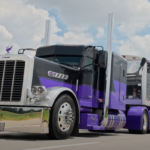California’s ambitious push towards achieving almost complete zero-emission passenger vehicles and heavy trucks will lead to an increased demand for electricity, resulting in higher prices and a greater reliance on commercial vehicles to maintain current freight levels. This initiative, driven by stringent laws also adopted by other states, seeks to eliminate carbon fuels from interstate transportation.
The American Transportation Research Institute (ATRI) conducted a detailed examination of the potential impact of a full transition to electric vehicles (EVs). In addition to their December 2022 report on “Charging Infrastructure Challenges for the U.S. Electric Vehicle Fleet,” which highlighted the substantial electricity requirements for a fully electrified U.S. vehicle fleet, ATRI’s latest analysis focuses on the specific implications for California.
California has already implemented laws mandating that trucks and buses operating within the state transition to 100% zero-emission transportation where feasible by 2045. Moreover, the state aims for all in-state sales of new passenger cars and trucks to be zero-emission by 2035.
ATRI’s recent forecast indicates that meeting these mandates would necessitate California generating 57.2% more electricity than its current output of 197,000 gigawatt hours (GWh), which is insufficient to meet existing demand. Consequently, the state would need to import an additional 50,000 GWh to satisfy its electricity needs adequately.
In summary, if California successfully implements its EV plans, the state would have to consume 57.2% more electricity than its current usage, as outlined in ATRI’s earlier report. It’s worth noting that California, with the second-highest average kilowatt hour cost for electricity at 22.33 cents, faces challenges in meeting this increased demand, making electricity imports crucial.
“With new battery-electric vehicle trucks costing more than $425,000 — more than double the cost of a comparable diesel truck — California’s supply chain will get more expensive. Additionally, the cost to power a battery-electric truck, including equipment, installation, utility upgrades and electricity, could be as high as $1.21 per mile, nearly double the cost per mile of diesel fuel,” ATRI stated.
EV charging for trucks also will spark another financial cost in truck parking facilities (already falling significantly short of demand).
“Adding a charger at each of California’s 13,144 truck parking spaces would cost between $1.472 billion and $2.878 billion for just the purchase and installation of the charging units,” ATRI noted.
California is confronted with an additional challenge stemming from the adoption of electric vehicles (EVs), namely, the impact of EV batteries on the weight of vehicles traveling on existing roadways and bridges. Many of these transportation infrastructures are currently aging and require repairs or replacement.
According to the American Transportation Research Institute (ATRI), their 2023 Operational Costs of Trucking report reveals that if today’s diesel tractors are replaced with significantly heavier electric trucks, approximately one-third of the truckload sector would exceed the weight limits set for U.S. roads. This means that a substantial portion of the industry’s trucks would become too heavy for the existing road infrastructure.
In the context of California’s push towards electrifying its transportation industry, this shift to heavier electric trucks would necessitate a larger fleet of EVs to transport the same amount of freight as a diesel truck. Essentially, the electrification process, while environmentally beneficial, introduces the challenge of increased vehicle weight, impacting the capacity of aging roadways and bridges and requiring additional adjustments to accommodate the evolving transportation landscape.
“For every 1,000 trucks, an additional 343 trucks would be required due to battery weight,” ATRI stated.





